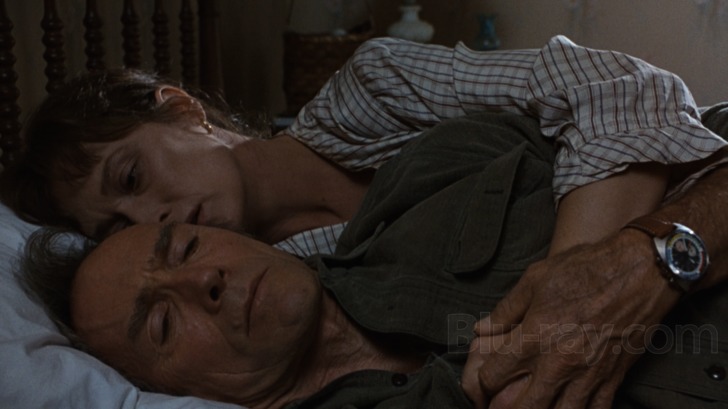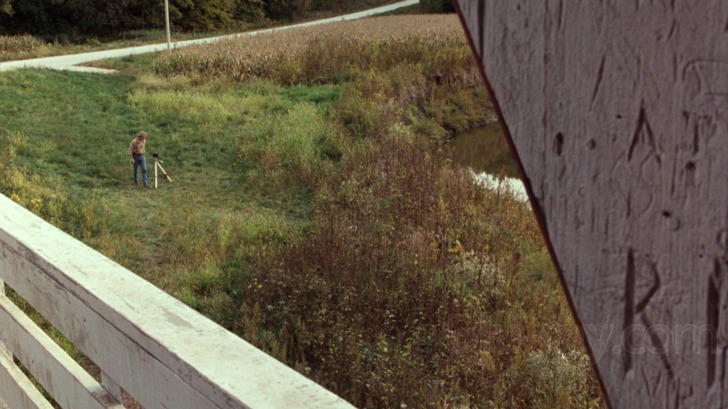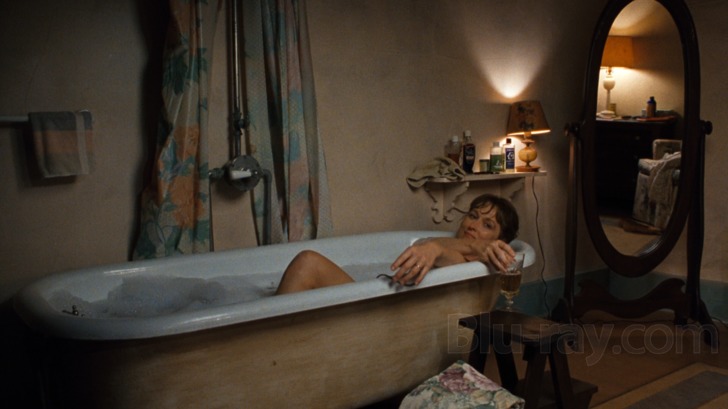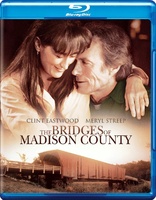The Bridges of Madison County Blu-ray Movie
HomeThe Bridges of Madison County Blu-ray Movie 
Warner Bros. | 1995 | 135 min | Rated PG-13 | May 06, 2014Movie rating
7.6 | / 10 |
Blu-ray rating
| Users | 4.0 | |
| Reviewer | 4.0 | |
| Overall | 4.0 |
Overview
The Bridges of Madison County (1995)
Photographer Robert Kincaid wanders into the life of housewife Francesca Johnson, for four days in the 1960s.
Starring: Clint Eastwood, Meryl Streep, Annie Corley, Victor Slezak, Jim HaynieDirector: Clint Eastwood
| Romance | Uncertain |
| Drama | Uncertain |
| Period | Uncertain |
Specifications
Video
Video codec: MPEG-4 AVC
Video resolution: 1080p
Aspect ratio: 1.78:1
Original aspect ratio: 1.85:1
Audio
English: DTS-HD Master Audio 5.1 (48kHz, 24-bit)
Portuguese: Dolby Digital 2.0
Spanish: Dolby Digital 5.1 (640 kbps)
Czech: Dolby Digital 2.0
German: Dolby Digital 5.1 (640 kbps)
Hungarian: Dolby Digital 2.0
Italian: Dolby Digital 5.1 (448 kbps)
Spanish: Dolby Digital 2.0
French: Dolby Digital 5.1 (640 kbps)
Polish: Dolby Digital 2.0
Japanese: Dolby Digital 5.1
Spanish 2.0=Latin; Japanese is hidden
Subtitles
English SDH, French, German SDH, Italian SDH, Japanese, Portuguese, Spanish, Cantonese, Czech, Hungarian, Korean, Mandarin (Traditional), Polish, Romanian
Discs
50GB Blu-ray Disc
Single disc (1 BD)
Playback
Region free
Review
Rating summary
| Movie | 4.0 | |
| Video | 4.0 | |
| Audio | 4.0 | |
| Extras | 3.0 | |
| Overall | 4.0 |
The Bridges of Madison County Blu-ray Movie Review
The Road Not Taken
Reviewed by Michael Reuben May 5, 2014Today no one bats an eye when Clint Eastwood tries a different film genre. Currently we're awaiting his first musical, Jersey Boys. But it was different in the mid-Nineties, when people were still getting used to the notion of Clint Eastwood, Oscar-winning director. When word circulated that The Man with No Name would direct and star in an adaptation of Robert James Waller's weepie about a middle-aged country wife's love affair, the reaction was a collective "Huh?" Waller's novel may have been a runaway bestseller, but its audience was almost entirely female. (On the commentary track, cinematographer Jack N. Green says that he's the only man he knows who enjoyed the book.) The role of the photographer Robert Kincaid hardly seemed suitable for Dirty Harry, and Waller's lush romanticism was an odd choice for Eastwood's low-key style of filmmaking. The match-up didn't compute. But according to Eastwood's long-time editor, Joel Cox, the real Clint Eastwood is much more like Kincaid than he is like the characters with which he's most associated in the public imagination. Steven Spielberg's Amblin Entertainment had acquired Waller's book in galleys and spent several years developing scripts with different writers, while different directors came and went (including Spielberg himself). A long-time Eastwood admirer, Spielberg himself wanted the actor to play Kincaid. When both men responded favorably to the adaptation written by screenwriter Richard LaGravenese (Behind the Candelabra), Spielberg asked Eastwood to direct. The film became a joint project by Amblin and Eastwood's Malpaso Productions. It was Eastwood, however, who insisted on casting Meryl Streep as Francesca Johnson, the Italian war bride living a life of quiet desperation in rural Iowa who rediscovers herself when Kincaid enters her life. Not only was Streep America's greatest living movie actress, but she was also 45 at the time, the same age as Francesca in the novel. Most others being considered for the part were younger, but Eastwood grasped that the power of Francesca's story depended on its being told by someone who had already lived a full life and who could convincingly convey the shock of the sudden metamorphosis wrought by this stranger's arrival. The response to the film put any doubts to rest. Bridges opened to strong reviews and even stronger box office. Fans of the novel were pleased, and many who had found it unbearably sentimental were astonished at how Eastwood and LaGravenese trimmed away the fat and extracted the human drama beneath Waller's sometimes purple prose. Eastwood, it turned out, could do serious drama—as he would prove again in Mystic River and Million Dollar Baby .

Throughout literature, the greatest love stories have always been those without happy endings. Bridges uses a framing device that tells the audience the end of Francesca's and Robert's relationship right at the outset. In the present day, Francesca Johnson's two adult children, Michael and Carolyn (Victor Slezak and Annie Corley), return to the farmhouse where they grew up in Winterset, Iowa, to settle the affairs of their recently deceased mother. There they discover a collection of letters and journals that their mother (Streep) has left for them in which she relates her four-day love affair with Robert Kincaid (Eastwood), a photographer for National Geographic, who stopped by to ask directions to one of the local covered bridges. Michael and Carolyn were teenagers at the time, and they had left for a few days with their father (Jim Haynie) to exhibit Carolyn's prize steer at the State Fair. The adult children are shocked, but in different ways. Michael is appalled at his mother's behavior, but Carolyn is primarily surprised that Francesca never shared this story with her daughter while she was still alive. Both of them are struggling with marital difficulties, and as they gradually discover this previously unknown chapter of their mother's life, they find themselves drawing closer together, as they look inward and begin re-examining their own lives. Eastwood's depiction of the relationship between Robert and Francesca cannot be adequately described in words. Indeed, the film's strength is that it doesn't have to rely on language to convey what Francesca calls the "pure and absolute" mystery of love. Eastwood uses wide lenses and long takes to let us observe two people suddenly recognizing something important and unexpected in each other. He lets the camera capture tiny gestures, subtle shifts of expression, pregnant pauses, exchanges of looks—all the minute details with which people communicate in real life and that great actors exhibit when they fully inhabit their characters. As Robert and Francesca explore bridges, dine together, exchange life stories, dance and gradually acknowledge their connection, so do Eastwood and Streep discover each other in performance. The electricity is palpable. (Eastwood has repeatedly said that he prefers to use the first take, or even shoot the rehearsal, because there is a unique energy when lines are spoken on set for the first time.) "Everything I knew to be true about myself was gone", Francesca says, in the spare voiceover. "I was acting like another woman, yet I was more myself than ever before." In Eastwood's hands, The Bridges of Madison County becomes more than a love story; it's an account of a transformative experience that allows two people to glimpse other possibilities, other parts of themselves that they didn't know were there (or knew and had forgotten). The tragedy is that neither of them can simply begin again. "I can't make an entire life disappear to start a new one", Francesca tells Robert as their time together draws to a close. She loves her children and her husband, and she won't abandon either them or the person she's been all these years. As for Robert, one suspects that he would find it difficult to give up the independence of the vagabond life to which he's grown accustomed. Still, as Eastwood has staged the couple's final, wordless meeting—in the rain, and once again dominated by small but important gestures—both we and Francesca are left wondering just how much Robert Kincaid might have been willing to sacrifice for the one woman in his life about whom, as he says, he is truly certain.
The Bridges of Madison County Blu-ray Movie, Video Quality 

The Bridges of Madison County was photographed by Jack N. Green, who had been a member of Eastwood's crew since 1978, when he began as a camera operator on Every Which Way But Loose. Eastwood promoted him to director of photography ten years later on Heartbreak Ridge, after which Green shot every Eastwood film through Space Cowboys in 2000. On the commentary track, Green discusses at length Eastwood's preference for soft, naturalistic light and backlighting. He dislikes intense contrast and avoids bold colors, unless they serve a specific purpose in the story. The image on Warner's 1080p, AVC-encoded Blu-ray reflects the soft image that Eastwood asked Green to deliver, but it still has plenty of detail within the film's limited settings. Francesca's house (a practical location completely restored by the production company) is filled with realistic furnishings, much of which can be readily discerned in the many wide shots. Fine points of her clothing and Robert's, and every wrinkle in Eastwood's face, are readily apparent. The texture of the covered wooden bridges, the surrounding foliage and the faces of the townspeople are equally detailed. Blacks are true, and contrast is never overstated (Green specifically says that Eastwood hates overblown whites). The palette favors earth tones, but a subtle warmth is gradually added to the lighting as the film progresses. The effect is intended to be subliminal; so you have to be looking for it. The film's grain pattern appears to be natural and undisturbed by untoward digital manipulation. At an average bitrate of 24.96 Mbps, Bridges falls at the high end of Warner's typical compression range, and it certainly appeared to be free of any artifacts. I note, however, that the BD-50 has approximately 10 GB of unused space. There was more than enough space to allow for less tight compression and more generous bandwidth.
The Bridges of Madison County Blu-ray Movie, Audio Quality 

The film's original 5.1 mix is presented in lossless DTS-HD MA. It's an understated mix that emphasizes dialogue and an occasional blues tune or opera selection to which Francesca and/or Robert listens, usually on the radio. Editor Joel Cox points out a particular effect where the song to which they are dancing expands into the full surround array, but that is probably the showiest moment on the soundtrack. A visit to an out-of-the-way blues bar provides perhaps the film's loudest passage. The dialogue is always clear, and the score by Lennie Niehaus (with the main theme written by Eastwood) provides a gently effective commentary on the action.
The Bridges of Madison County Blu-ray Movie, Special Features and Extras 

Warner first released Bridges on DVD in 2004 with only production notes as extras. A "deluxe edition" appeared in 2008, and was reissued two years later as part of the Clint Eastwood Collection, with new extras, all of which have been ported over to Blu-ray:
- Commentary with Editor Joel Cox and Director of Photography Jack N. Green: Cox is the more voluble of the two commentators, but both men are enthusiastic about Bridges. They discuss their work on that film in particular and working with Eastwood in general. A degree of hero worship is inevitable, since both men owe their careers to the producer/director/star. Still, Green was on the set for every day of shooting, and Cox looked at every frame of film that was printed (a subject on which his comments are particularly interesting, since not every editor does so). Together, they are uniquely qualified to discuss the making of Bridges. Cox also discusses why there are never any "deleted scenes" on the home video version of a Clint Eastwood film.
- An Old-Fashioned Love Story: Making The Bridges of Madison County (480i; 1.78:1, enhanced; 29:36): This excellent documentary includes interviews with all of the principal cast, including Slezak, Corley and Haynie, as well as producer Kathleen Kennedy, Cox, Green and production designer Jeannine Oppewall.
- Music Video: "Doe Eyes" (480i; 1.33:1; 4:05): An instrumental version of the film's main theme accompanying a compilation of clips.
- Theatrical Trailer (480i; 1.78:1; 1:23). More a teaser than a trailer.
The Bridges of Madison County Blu-ray Movie, Overall Score and Recommendation 

The Bridges of Madison County moves at the deliberate pace of the kind of adult drama that is increasingly disappearing from mainstream American films. Nine years later, when Eastwood was trying to get studio backing for Million Dollar Baby, one studio told him directly: "We don't make dramas." If Bridges hadn't come with the cachet of a bestselling novel and the backing of Steven Spielberg's Amblin, it's unlikely that Eastwood would have been able to make the film in his low-key style. As it turned out, his brand of understatement is essential to the film's artistic merit. Warner's Blu-ray is a capable presentation and is highly recommended.
Similar titles
Similar titles you might also like

Millie
1931

Anna Karenina
2012

Beloved Infidel
Limited Edition to 3000 - SOLD OUT
1959

Last Night
2010

Revolutionary Road
2008

Closer
2004

Frida
2002

Terms of Endearment 4K
Paramount Presents #42
1983

The Jane Austen Book Club
2007

The Painted Veil
2006

Rachel Getting Married
2008

The Disappearance of Eleanor Rigby
Includes "Him", "Her", and "Them" Cuts
2014

New York, I Love You
2009

Intermezzo: A Love Story
1939

Brief Encounter
1945

Northanger Abbey
2007

Sense and Sensibility 4K
30th Anniversary
1995

Wuthering Heights
2009

Little Dorrit
2008

Maurice
1987
